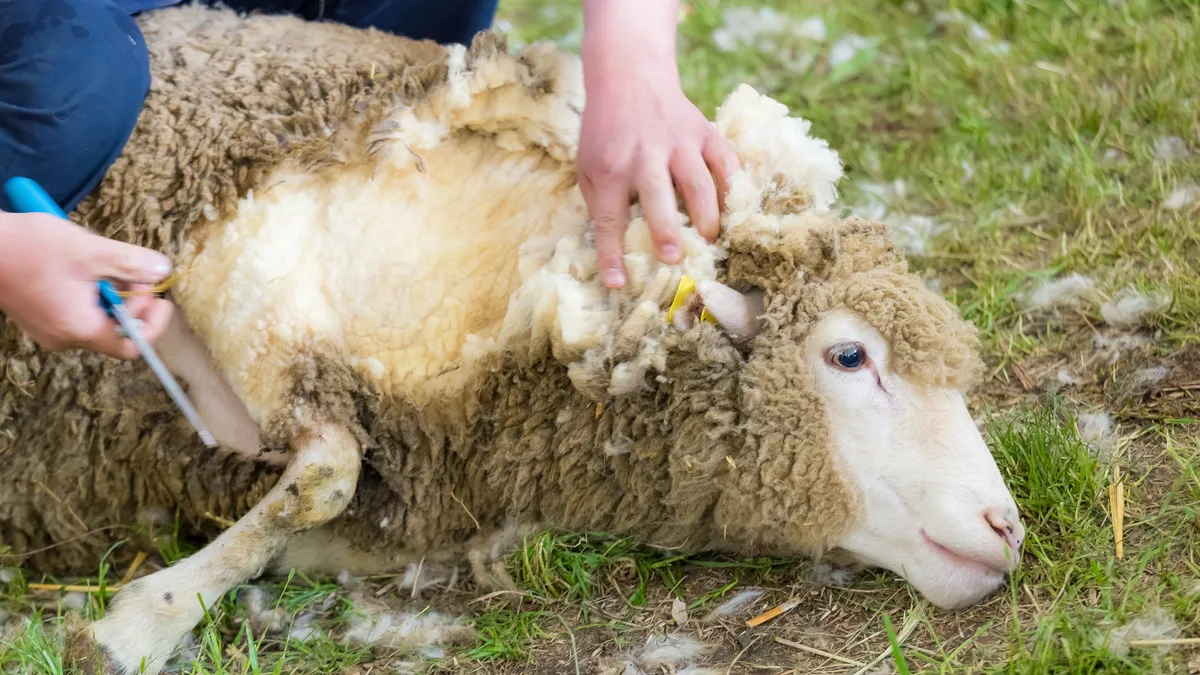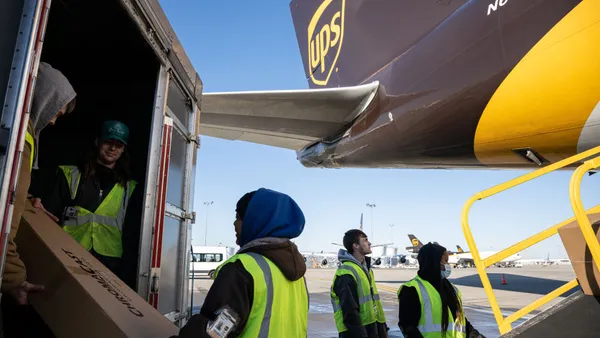At the annual Kindergarten Day at Pisgah High School in Canton, North Carolina, agriculture teachers Courtney Smith and Joshua Justice hand most of the reins to the 150 or so high schoolers who explain the different events, from sheep shearing to beekeeping.
A few students will sometimes try to take what they think is a less-involved role and sign up for line leader — until they discover that they have to learn about every station, said Justice.
“We do trick them a bit,” he said, joking.
But ultimately, that’s the goal for Justice and Smith — to have students, whether the high school pupils they teach or the kindergartners they invite, learn as much as they can about how a farm works, from raising animals to growing food.
“We ask the students, ‘Where do meat and milk come from?’ Inevitably, we have a couple of students who say, ‘The grocery store,’ and don’t see the connection,” said Smith. “So we’re doing a good job of starting to plant that seed that there are purposes for every animal beyond standing in front of you looking cute.”
Farm and field days may vary nationwide, but the agricultural industry themes tend to be a constant. The underlying details may include learning about why bees should be allowed to keep their honey for the winter months, the way to handle a grain silo emergency if someone is trapped, the differences between genetically modified and non-GMO crops, or even what happens to a sow after giving birth to piglets.
While on-campus agricultural programs are designed to teach students about potential careers and opportunities, farm and field days are meant to give younger students a taste of these areas and whet their appetites for future studies.
Here are three ways farm days help to bring more insight into agricultural experiences for students.
Animal husbandry
The annual Kindergarten Day each April is such a hit that the lower school teachers reach out to either Justice or Smith, who launched the event 11 years ago, if they haven’t received the Google sign-up sheet by February.
“They enjoy it as much as the kindergartners do, sometimes more,” said Smith. “And we don’t try to plan it, but [the event] often ties into what they’re teaching the students in their curriculum.”
Part of the program at the high school is helping students learn the difference between animals that are raised as food and those that are pets — and the school has sheep, goats, pigs and occasionally cattle on site, said Justice and Smith. The school will be working with chickens this year and is looking to have some hatching projects, added Smith.
Justice explained that students learn the difference between how dogs are treated and the industry standards for farm animals, including practices such as ear tagging.
“That allows us to explain why things are done the way they are, the humane and the inhumane side of things,” he said.
During the April event, the kindergartners watch some of the school’s sheep get shorn. While Justice handles the shears himself for safety reasons, high schoolers serve as the station experts. They research and write speeches explaining the details around the reasons for shearing, what breeds need to be sheared and which ones don’t, and which sheep have better wool for spinning into clothes.
“A lot of the kids come up with their own spin on things, which helps them explain what they’re going to talk about,” he said. “They learn a lot more in-depth knowledge about that subject.”
Equipment and animal safety
In South Carolina, an Agricultural Safety Days event run through Clemson University is designed for high school students rather than being held by them.
Hunter Massey, a senior lecturer with the university’s Agricultural Sciences Department who runs the Agricultural Safety Program, hopes to bring the opportunity to younger students, too.
“The logic is that these are the students who will one day work for a farmer, and this gives them a little bit of training,” said Massey. “It allows them to be better employees, and that’s why we started this.”
The program holds Agricultural Safety Days at four different locations throughout the state, from rural areas — where students are likely to be familiar with farms — to more dense areas where students are “farther removed” from farm life, said Massey. About 550 students and teachers attend the events each year, he added.
While not every student will go on to work in the agriculture business, Massey hopes it still gives them an idea of what a farmer goes through to produce the food or clothes students encounter and helps them understand it’s not a single process.
Programming can include learning about an animal’s fight or flight response, so they know how a farm animal may react and respond. Students also learn how to safely mix pesticides and what to do if a chemical gets on their skin. Another focus involves a grain silo simulator which teaches students how fast grain can fill a silo, and how quickly someone can become trapped.
The end of the day is typically the students’ favorite, said Massey. Classes drive a new tractor on a mini-driving course, maneuvering around trees, backing up, and sometimes using the loader.
While Massey knows not all students will use the information at a future job or even pursue a career in agriculture, he said giving them a chance to learn these details opens the door to possibilities students themselves never considered.
“You can’t know you may have an interest in something if you’re not exposed to it,” he said. “At least all of them have the opportunity to understand what it took to pick 100 acres of corn or how their food is processed.”
The culture of agriculture
At Nelson County High School in Lovingston, Virginia, about 60 high schoolers help throughout the annual FFA Field Day, which introduces the district’s 4th-graders — about 120 a year — to food and animal science, said Cole Ramsey, the school’s agricultural science teacher and FFA advisor. Some students bring in heifers and pigs they’re raising as show projects to the event, he added.
Ramsey noted that there are plenty of livestock on campus for elementary school students to view, including chicken, geese, lambs, ewes and a flock of sheep raised at the high school itself. A dairy farmer also shows how the milking process has changed, with a dairy cow and “tricked out” trailer on display, he said.
“We live in a rural community, so it’s things they may have seen but may not understand,” said Ramsey. “As consumers, it gives them a basic education in the agricultural industry and where their food comes from.”
He said that high schoolers teach classes, help the students pot a strawberry plant they can take home, and prepare food for lunches. Dessert is sometimes a “dirt cup” where Cocoa Puffs serve as bedrock and crumbled Oreos as organic matter, with a gummy worm on top.
“They’re making a dessert but also learning about soil profiles,” said Ramsey.
The district promotes a theme that involves students teaching other students throughout the agricultural program, whether that’s seniors coaching middle school students for upcoming FFA contests or during the Field Day event, said Ramsey.
“It’s cool to see a 6th grader who knows a senior and knows what they can accomplish if you work hard,” Ramsey said. “And it’s great as a teacher to see the next group coaching and teaching its next students.”




















